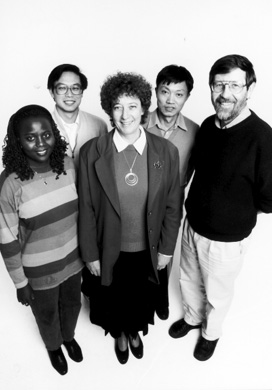GEMOC's international links
background
- GEMOC has strong international links particularly with the former USSR and Asia including China, Japan, Mongolia, Myanmar and Thailand
- targeted Asian regions have geological similarities and contrasts that help us to interpret the geological structure and metallogenic framework of the Australian continent: they provide more easily studied analogues to some of the tectonic terranes
- models for continental breakup and reassembly show that during at least two major times of continental rearrangement, parts of the Australian continent split off and ultimately docked to form parts of east Asia
- detailed investigations of terrane boundaries in Asia and eastern Australia should be able to shed more light on this aspect of great significance to the location of some economic deposits

|
examples of active funded projects in Asia
|
| The sweep of the China/Mongolia/Siberia lithosphere traverse |
other international links
funded collaborative projects initiated 1997 include:
- Igneous rocks, mineral deposits and tectonic setting: southeastern China and eastern Australia (with Nanjing University led in China by Prof. Zhou Xinmin with reciprocal funding from China sources). This is funded by AusAID for 3 years from July 1997
- Lithosphere Mapping in eastern China (with a Consortium of participating institutions in a 5-year National Priority Program funded by China NSF from 1997, led in China by Prof Zhou Xinhua of the Geological Institute, Academy of Sciences, Beijing). Results and material from GEMOC's previous International Links Project played a key role in the success of this project funding

Some of the participants in the new AusAID-funded Australia China Institutional Links Program. From left to right: Yvette Poudjom Djomani, Xisheng Xu, Suzanne O'Reilly, Ming Zhang and William Griffin.
- Nature of Siberian Lithosphere (with WMC)
- Canadian shield lithosphere structure (with Kennecott Canada)
- Thermal and petrologic structure of the Rio Grande Rift and Baja California (with USA partners)
- Deccan plume mantle (with Pune University)
- Kerguelen Archipelago lithosphere structure (with the University of St Etienne)
funded collaborative projects ongoing in 1997
include:
- Inclusions in diamonds from Canadian lithosphere (with Kennecott Canada)
- Thailand diamonds, sapphires and basalts (with Kasetstart University, Myanmar Ministry of Mines and CSIRO)
GEMOC participants also have a wide range of research collaborations
with colleagues in UK, USA, Europe (France, Germany, Norway).
other activities 1997
- S. Y. O'Reilly and W. L. Griffin were installed as Concurrent Professors at Nanjing University at a formal ceremony followed by a banquet attended by three generations of Vice-Chancellors.
- Extended visits by international collaborators to undertake discrete research projects (see Appendix 3)
Refer to the Research Program and Postgraduate sections of this Report for details of collaborative research projects and postgraduate exchanges.

 GEMOC ARC National Key Centre
GEMOC ARC National Key Centre